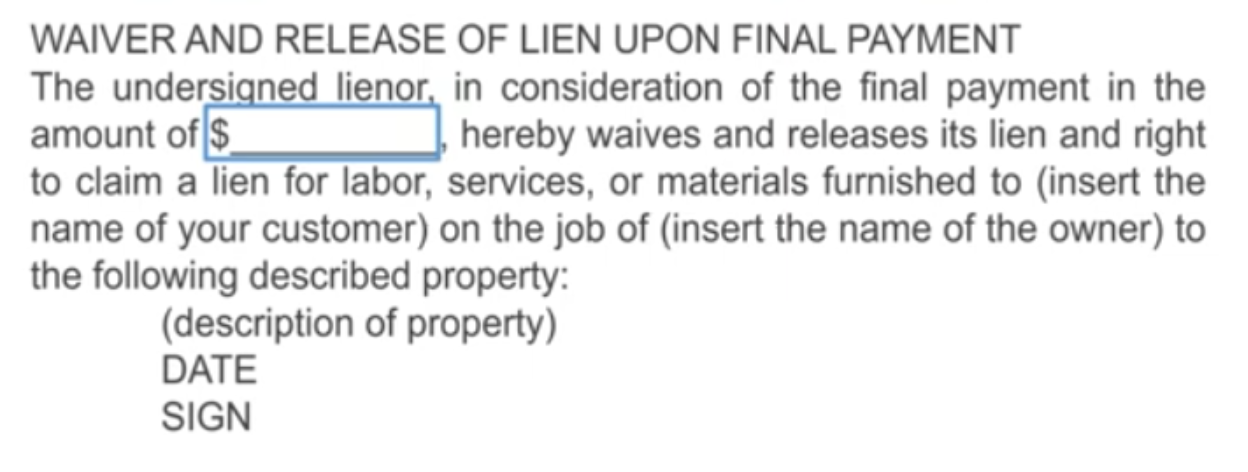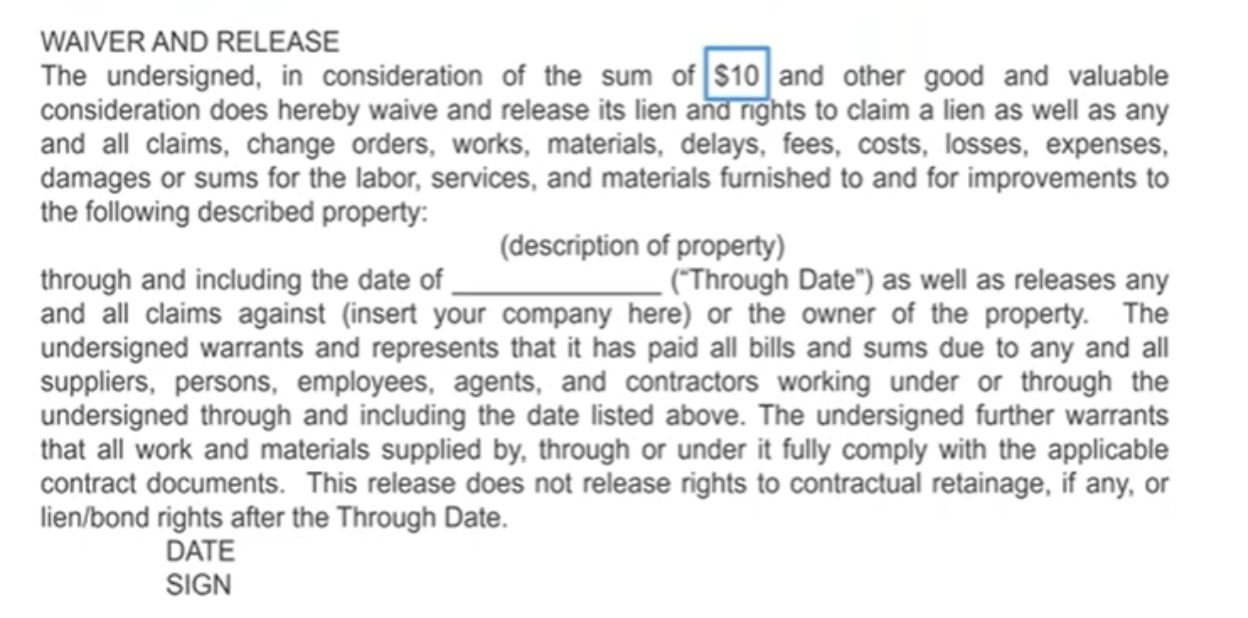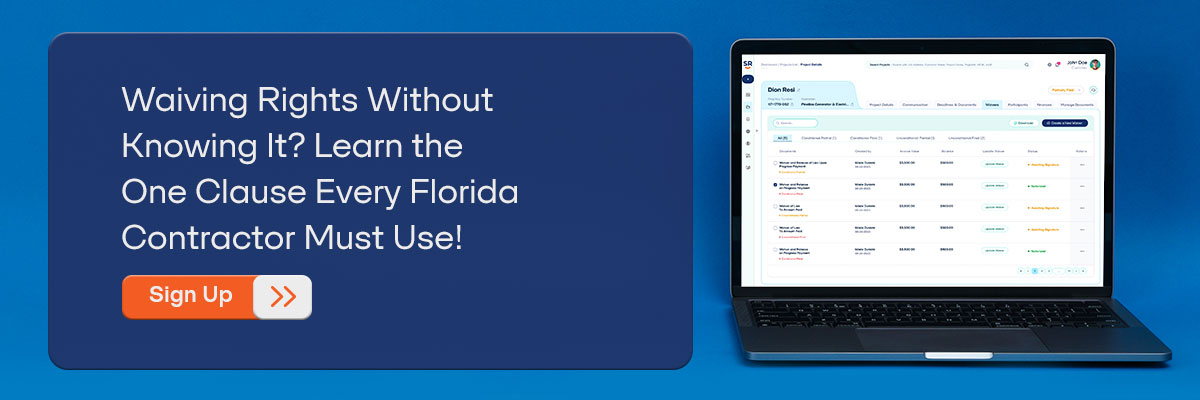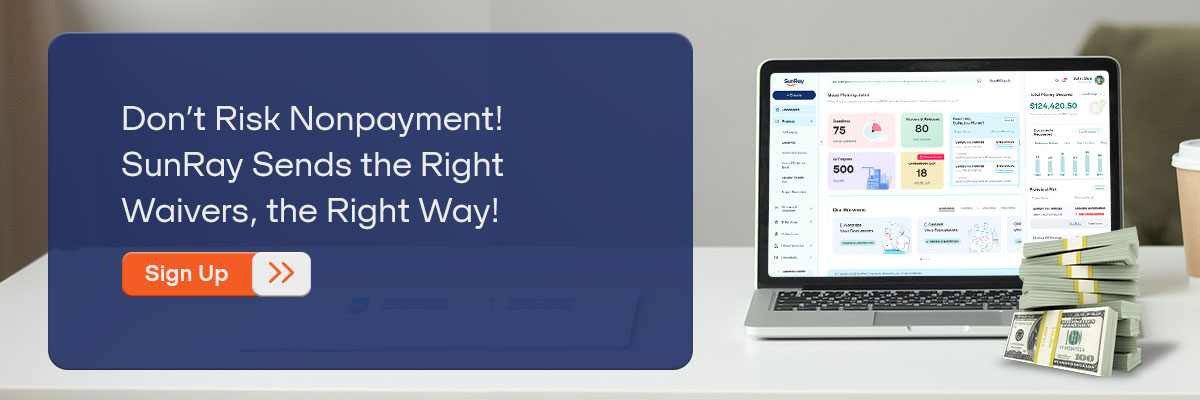Stop! Don’t Sign That Waiver Unless It Says This - Florida Webinar
In this webinar, contractors, subcontractors and suppliers in Florida can learn in detail about releases and waivers and what they must make sure the release says before signing it.
Last updated:
Nov
07
,
2025
Published:
July 23, 2025
Read
Releases and waivers are key construction documents, and it’s essential for construction professionals to understand how they should be used. Several elements must be reviewed before signing a waiver, as using the wrong form can lead to non-payment. That’s why it’s important to know the different types of releases and to carefully check the waiver form before signing.
In this blog, presented by SunRay Construction Solutions and Alex Barthet, Principal at The Barthet Firm, Florida construction professionals will learn about the different types of releases, the essential steps to take with every release, and more.
Releases and their Various Forms
When it comes to releases, there are several types, and choosing the right one depends on your position in the construction chain. For instance, the type of release a general contractor uses will be different from the one a subcontractor should use.
- If you're a subcontractor, it's generally best to use a narrow release, one that limits the rights you're giving up. Subcontractors typically have multiple rights, such as contract rights, lien rights, and equitable rights. When you receive a payment, you should aim to waive as few of those rights as possible.
- On the other hand, if you're a general contractor issuing a check, you’ll want to obtain the broadest release possible, so you should use a broad release. That release should cover everything, so the party receiving the payment cannot come back later and demands more money.
This is why it's critical to read every release form carefully before signing. Florida law includes some default statutory release forms in Chapter 713, but not all situations are covered by these forms. Understanding what you're signing and what rights you're giving up is key to protecting your financial interests. Below is an example of a progress payment statutory release form:

- As you can see in the release form above, you’ll need to enter the amount due, the through date, the name of your customer, the name of the property owner, and a description of the property.
- The two most important pieces of information in this form are the amount owed and the through date, which is the date through which your rights are being released.
- At the bottom of the form, it states that the waiver and release do not cover any retention, labor, services, or materials furnished after the specified date. That specified date refers to your through date.
- For example, if you are expecting a check for $30,000, you would enter $30,000 as the amount owed, and the through date would reflect the last date that the payment covers.

Here is an example of a final payment statutory release form:

- Similar to the previous form, this release also requires you to enter the amount owed, the name of the customer, the name of the property owner, and a description of the property.
- However, you’ll notice that this form does not include a through date. That’s because this release becomes effective as of the date you sign it. So, if you sign the release today, you are waiving all of your lien rights up to and including today.
- Another key difference is that this form does not include the catch-all statement found in the previous version, the one that excluded retainage and lien rights that may accrue in the future.
Below is a third type of release form, and as you can see, this has considerably more words than the previous two forms.

- This release form has broadened the releases that you are given.
- Unlike the statutory release forms where you are only releasing the lien rights, in this type of release forms, you are also releasing a lot of other rights, such as change order rights, delay rights, etc.
So, you need to be really cautious while signing a release form to understand what the rights that you are giving up are. This is why you must read every release before you sign it. It may happen that you have been signing the same release form for the first two payments, but for the third payment, there are some additional languages included in the form.

If you sign the form without reading it, then you may be giving up rights that you didn't know about because you read the first release that you signed, and then every other release you just sign because you assume it's the same.
- This release form also says that you warrant and represent that you've paid all your bills.
- It also says that you warrant that all work supplied by, through, or under it fully complies with the applicable contract documents.
You need to bear in mind that sometimes people use release forms not only to release rights but to get you to verify certain facts. Because if those facts are not true, not only can they sue you for breach of contract, but now they have a document signed by you that is likely notarized, which means it is under oath, and it may be used against you later.
As mentioned earlier, we have two types of release forms – narrow and broad, and the above form falls under the broad release category. This is the type of release form you should use if you are an owner paying the GC, or you are the GC paying the subcontractor, or you are the subcontractor paying the supplier or sub-subcontractor.
However, if you are on the other side, which means you are the one signing the release, then you should try and avoid such a broad release because you may end up giving up several rights that you may need later.
How to Manage Releases During a Project
So, how do you deal with the release forms during the course of your project?
- When you're asked to sign a contract, the first step is to check whether the contract includes sample release forms that you are expected to sign each time you submit a payment request.
- If they are included, you’ll need to review and negotiate those release forms.
- For example, many contracts contain numerous terms, conditions, and exhibits. Somewhere in the contract, it may state that when you submit your pay request, you must use the release form attached as Exhibit S. In such cases, you need to review Exhibit S and determine whether you're willing to sign that form each time.
- Once you sign the contract, you agree to use that specific release form.
Key Action Items
One key action item you should take while reviewing the contract is to add a sentence that states:
“The parties agree that Chapter 713.20 forms of release shall be used for all partial and final release forms, they will be conditioned upon payment, and the Subcontractor may include exceptions in the release.”
- The first part of the statement specifies that you will use the statutory release forms, which are generally the narrowest forms—meaning you are only releasing your lien rights.
- The second part says that the release is conditioned upon payment. This means the release becomes effective only if the check clears.
- Some owners or contractors may reject conditional releases; however, you must negotiate and ensure that you have the right to use them.
- The last part of the sentence allows subcontractors to include exceptions in the release.
For example, if you have a pending change order that hasn’t been approved, but you've completed the work and are owed an additional $20,000, you would add an exception to the release that says:
“This release excludes pending Change Order Number XX in the amount of $20,000.”
If you sign a broad release, you will likely give up your rights to that change order in the event of a dispute.
Some contractors may not accept releases that contain exclusions. However, if your contract includes the right to list exceptions, they cannot object to such a release when you submit it for payment.
Always Do This 1 Thing!
So, what is the one thing that you absolutely must do?
- You must ensure that the “through date” matches the amount you are being paid.
- The “through date” is the effective date of your release, and it takes precedence over the payment amount.
- If the through date and the payment amount don’t match, you must adjust one, the other, or both so that they align.
For example, let’s say you performed work in the month of June and are owed $50,000.
When you submit your pay application, you're told that you’ll be paid only $30,000.
This creates a problem because the work you did in June is worth $50,000, not $30,000. You might assume the remaining $20,000 will be paid later, but that may not happen.
If you sign a release in exchange for the $30,000 and agree to waive all rights through the end of June, and later take the matter to court, the judge may determine that you accepted $30,000 in full settlement for your work through June.
That’s why it’s so important to pay attention to the “through date.” In this situation, you have two options:
- You can insist on being paid $50,000 if they want you to release your rights through the end of June; or
- You can adjust the through date to reflect the portion of work worth $30,000—essentially identifying the date through which that partial payment applies.
This ensures that you retain your rights to the remaining $20,000.
What About Conditional Releases?
A conditional release is expressly conditioned upon actual payment—you should use it when you haven’t received the money yet. It’s essentially a promise to waive rights only once payment is received, and this includes situations where payment is made by check, since there's always a chance the check could bounce or not clear.
To protect yourself, you can include language such as:
“Notwithstanding anything to the contrary, this waiver and release is conditioned upon and not effective until the undersigned receives paid funds of $_________.”
Applying this to our earlier example—if you are signing a release for $50,000, make sure the release is explicitly conditional upon receipt of the $50,000.
Another important point: many release forms are labeled as conditional, but when you read the actual language, they contain no true condition. This is why it's critical to read every release thoroughly—don’t rely on the title alone.
Also, keep in mind: you cannot have a $10 conditional release. You must clearly state the actual amount required to satisfy the condition, which, in our example, is $50,000.

Key Takeaways
To summarize, remember:
- Read your releases thoroughly.
- Based on where you fall in the construction chain, use the appropriate type of release form – narrow or broad.
- Make sure the through date and payment always match.
- Use conditional release forms to safeguard your rights.
To better understand your lien rights, check out our guides on the Notice to Owner Florida and the Florida Mechanics Lien.
Protect Your Rights with a Notice to Owner
Sending a notice to owner is the first step to secure payment on construction projects. Learn how a notice to owner Florida helps protect your lien rights and ensures you get paid.
Common Questions Contractors Ask
1. Why does the release say I received $10 when I didn’t? This is very confusing!
This is one of the most common points of confusion and frustration for both contractors and their customers. The $10 on a release is a legal placeholder, also known as a “legal fiction.” It doesn’t mean you were actually paid $10. It simply acknowledges that some amount of money changed hands. It’s used in a few specific scenarios:
- No money changed hands at all, but a release is still required because you filed a Notice to Owner.
- Confidentiality reasons – Contractors don’t want the payment amount listed because it might be passed up the chain and reveal sensitive bid or contract pricing.
- Avoiding disputes – If you’re giving someone a check for $8,000 and they thought it was $10,000, a $10 release prevents that argument from happening.
Pro Tip:
- If you’re paying someone and collecting a release, we recommend using the $10 version.
- If you’re signing a release in exchange for payment, cross out the $10 and write in the exact amount you’re receiving. This ensures there are no misunderstandings about what rights you're waiving.
2. If our progress payment release doesn’t mention a specific change order (CO), can we still get paid for that CO later?
This comes up a lot, especially on fast-moving projects where change order paperwork lags behind the actual work.
Here’s the bottom line:
- It's not about whether the work was completed, it's about whether there’s a signed change order in place.
- If the change order isn’t signed, the work is not technically part of your contract — which means it can get left out of payments and releases.
To protect yourself, always include language in your release that excludes unsigned change orders, such as:
“This release does not include Change Order Request #14 dated June 11th in the amount of $20,000.”
Once the CO is signed, it becomes part of your contract and is easier to bill and collect.
3. I’m a GC and don’t like receiving conditional waivers from sub-vendors. If they don’t get paid, I won’t know. Is that a valid concern?
Yes, absolutely.
If you’re receiving releases, conditional waivers can be risky, especially when you're not the one directly paying that party (like a supplier to your subcontractor). Just because you issued a check doesn’t mean it reached everyone down the chain.
Our recommendation:
Ask for two releases every billing cycle:
- A conditional release for the current month’s payment.
- An unconditional release for the previous month.
That way, the only uncertainty is limited to the current period, and you’re much less likely to get blindsided by a Notice of Non-Payment.
4. Should I wait to sign a release until my change order is signed?
It’s tempting to wait but that could delay payment for the rest of your work.
Instead, sign the release but clearly exclude the unsigned change order by including an exception like:
“This release does not waive Change Order Request #14 dated June 11th.”
This way, you can collect the undisputed money now, while still preserving your right to pursue the change order payment later.












